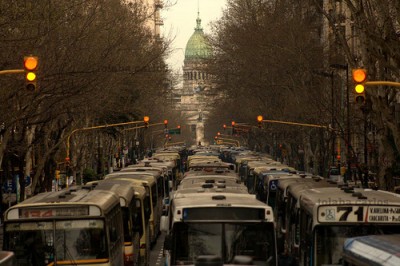Taking public transportation to get around in Buenos Aires is an experience in and of itself. The city covers over 202 square kilometers, which is divided into 48 official neighborhoods (barrios in Spanish) and has over 3 million inhabitants. As a business and trade capital of South America, the public transportation that you use to get from your Mente Argentina apartment or Argentine homestay to your internship in Buenos Aires is also used by the locals, young and old, people living in the city and out in la provincia (the province), tourists and travelers all year long! Here are some tips on how to get around:
Subte (Subway)
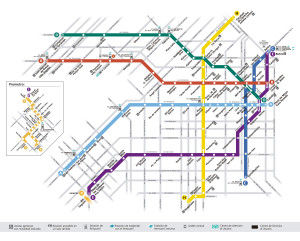 The Buenos Aires subway system has 6 lines, differentiated by color and number. Lines H (yellow) and C (dark blue) both run North to South and also serve as connections while lines E (purple), A (light blue), B (red) and D (green) run East to West. All the lines converge in what is considered city center, around Corrientes and Av. 9 de Julio or near Plaza de Mayo where the Casa Rosada (where the president works) is located. As Mente Argentina study abroad participants, you will mostly be using the D line that runs down and Av. Santa Fe, going through the center of the city as well as Palermo, Recoleta, Belgrano to get to you accomodations, Spanish classes and internships.
The Buenos Aires subway system has 6 lines, differentiated by color and number. Lines H (yellow) and C (dark blue) both run North to South and also serve as connections while lines E (purple), A (light blue), B (red) and D (green) run East to West. All the lines converge in what is considered city center, around Corrientes and Av. 9 de Julio or near Plaza de Mayo where the Casa Rosada (where the president works) is located. As Mente Argentina study abroad participants, you will mostly be using the D line that runs down and Av. Santa Fe, going through the center of the city as well as Palermo, Recoleta, Belgrano to get to you accomodations, Spanish classes and internships.
- Fun Fact: The A (light blue) line is the original subway line opened in 1913 making it the first subway system in all of Latin America and the Southern hemisphere.
Colectivo (Bus)
The bus system in Buenos Aires can seem quite complicated at first, but after a w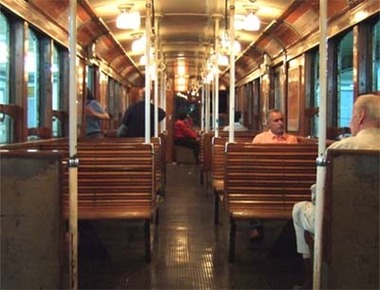 eek or so of getting used to, you will adjust. Afterall, it is one of the truest porteño experiences one can have! Finally learning how to navigate a couple of bus lines is a satisfying (and practical) accomplishment. There are over 135 working bus lines going not only through every neighborhood in the city, but also to several cities in the Buenos Aires province. Flag down the bus from the bus stop (numbered – they won’t stop at other bus stops), and once on, tell the driver your destination and he will charge you accordingly.
eek or so of getting used to, you will adjust. Afterall, it is one of the truest porteño experiences one can have! Finally learning how to navigate a couple of bus lines is a satisfying (and practical) accomplishment. There are over 135 working bus lines going not only through every neighborhood in the city, but also to several cities in the Buenos Aires province. Flag down the bus from the bus stop (numbered – they won’t stop at other bus stops), and once on, tell the driver your destination and he will charge you accordingly.
- Fun Fact: The bus system used to work on commission for the bus drivers but it became dangerously competitive, and the buses stopped being efficient AND safe. Drivers would choose not to stop when it wasn’t worth it for the number of passengers they could pick up, and would drive more recklessly. As a solution to these issues, it was changed into a privatized system, meaning individual bus companies own individual bus lines.
Trenes Urbanos (Urban Trains)
The trains are used mostly by those living out in the province of Buenos Aires, only about a 40 minute (or less) commute from the city. The train is an incredibly easy and economic way for commuters and travelers to get in an out of the capital. There are also long distance trains that can take you to cities outside of the Buenos Aires province, like Córdoba, Tucumán, Rosario, and more. There are a number of different urban trains, but they aren’t used as frequently as the buses or subway. One common trip is the train to Tigre, a city outside of Capital Federal on the Río de la Plata delta, that is often considered a nature escape to the porteños. You will get the train experience and a taste of Tigre on our Tigre Excursion in Buenos Aires included in the program, but if that’s not enough, hop on the train from Barrio Chino (Chinatown) or Retiro for a day trip out of the city!
Taxis
Taxis in Buenos Aires, like in any big city, are almost always run through a recognized taxi company. These are marked as Radio Taxis on the doors or taxi light on top. The Radio Taxi sign simply shows that said taxi is associated with a company that you could call and access, which makes it safer. Inside, you’ll see a tag showing the driver’s information and license. Though most taxis are painted yellow and black and say taxi on them, not all are radio taxis, and are not your safest bet.
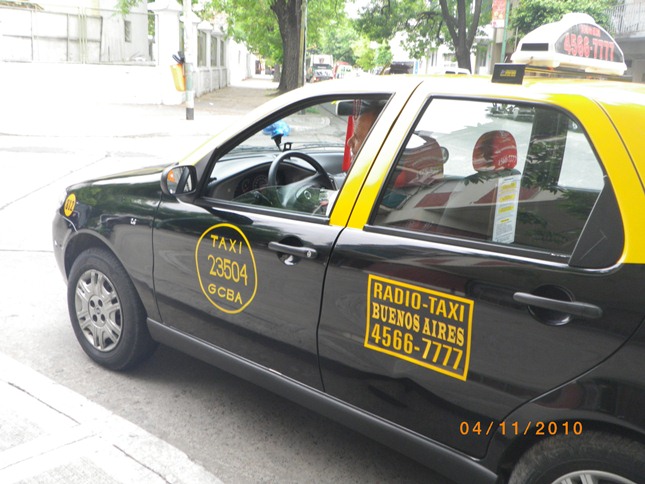 Fun Fact: Companies and frequent travelers also use Remises which are similar to taxis but are run through a car service. They have a fixed rate and only work when prearranged so it is a very secure form of travel. When coming to Buenos Aires to study, you will see our Remis or Taxi waiting to pick you up and take you straight to your accommodation. For more information about how to get to and from the airport, check out this blog post.
Fun Fact: Companies and frequent travelers also use Remises which are similar to taxis but are run through a car service. They have a fixed rate and only work when prearranged so it is a very secure form of travel. When coming to Buenos Aires to study, you will see our Remis or Taxi waiting to pick you up and take you straight to your accommodation. For more information about how to get to and from the airport, check out this blog post.
Payment & Navigation
Public transportation in Buenos Aires is relatively cheap. Ranging from 18-20 pe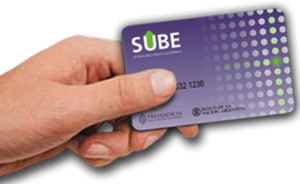 sos per ride, each ride can be paid using your SUBE card. You can load pesos on your SUBE at any subway station and at some kioskos (small convenient stores) as well. You can buy a SUBE card at most kioskos. If you are a Mente participant, you will receive a SUBE card upon your arrival in Buenos Aires. The SUBE card goes to -45, so even if you have 2 pesos left, you’ll still be able to take a few more rides in negative.
sos per ride, each ride can be paid using your SUBE card. You can load pesos on your SUBE at any subway station and at some kioskos (small convenient stores) as well. You can buy a SUBE card at most kioskos. If you are a Mente participant, you will receive a SUBE card upon your arrival in Buenos Aires. The SUBE card goes to -45, so even if you have 2 pesos left, you’ll still be able to take a few more rides in negative.
For those who are tech savvy, the easiest way to navigate public transportation is to use the handy applications that tell you how to get from A to B using the buses, subte, and even on foot or on bike. Check out our blog post about Helpful websites and apps for more information. It is a good idea to download the offline map of Buenos Aires just in case you get lost and don’t have credit on your phone.
When unsure, don’t forget about the good ol’ option of asking a local. Porteños tend to be very friendly and impressively well-informed about how to get to where you need to go. It is a great way to practice your Spanish and strike up a conversation.
Suerte!
Written by: Rachel Sherman
Edited by: Heather Houde
Updated by: Rachel Orga

